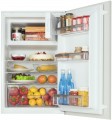Total capacity
The total volume of a refrigerator is the sum of the volumes of all its compartments, which can vary in specific capacity between different models. It's important to consider this when choosing a refrigerator.
A larger volume for a refrigerator can be beneficial for accommodating more food, but it can also increase the price and size of the appliance. This is especially important to consider if you plan to build the refrigerator into a specific space.
Refrigerator capacity
The refrigerating compartment is designed for storage of products that do not require freezing, i.e. cooling down to temperatures below zero. The temperature range inside varies from +2 to +10. In almost all modern refrigerators, it is this compartment that has the largest volume.
To ensure optimal performance and food quality, it's important to choose the appropriate volume for the refrigerating compartment based on your actual food storage needs and how often you replenish your supplies. Overfilling the compartment can have a negative impact on both the refrigerator's performance and the quality of the stored food.
For singles or couples, a refrigerating compartment of up to 200 liters is enough, while families or those who stock up on food should opt for models with up to 400 liters. Vertical refrigerators with separate freezer access are suitable for those who need moderate storage space, while side-by-side refrigerators with their typically larger volumes are a good option for those who require even more space and have ample free space.
Freezer capacity
The primary function of the freezer is to store food in a state of deep freeze, which helps preserve perishable products such as meat, vegetables, fruits, etc. for extended periods of time. The necessary volume of the freezer depends on the planned amount of food to be stored and the length of time it will be stored. A larger freezer is particularly useful if you plan to store food for several months.
A compact freezer is relevant for short-term storage (for a day or two) or for seasonal devices (for example, in the village). It is best to ensure that the freezer is not overloaded and has enough space for proper circulation of air to maintain the desired temperature.
Freezer temperature
The lowest temperature provided by a refrigerator freezer.
The lower the freezer temperature indicator, the more advanced the freezer is considered to be, and the better it is suited for long-term food storage with wider capabilities. It's important to note that the standard operating temperature for a fully functional freezer is -18 °C, which is suitable for both storing and freezing pre-frozen foods. Some refrigerators are designed with a temperature indicator of -24 °C, but this is mainly achieved through the quick freezing mode (see "Functions"), and the standard operating temperature is still -18 °C. However, if you plan to freeze food frequently and store it for extended periods, it's better to choose a model with a temperature of -24 °C and consider the freezing power as well.
Less expensive refrigerators have a less advanced freezer with a modest minimum temperature of -12°C or even -6°C, which is only suitable for storing pre-frozen foods, not for freezing fresh food. Although they are much more affordable.
To indicate the temperature of the freezer, markings in the form of asterisks (snowflakes) are often used, each of which means a decrease in temperature by 6 °C. For example, the mentioned -18 °C will correspond to 3 asterisks (***).
Autonomy time
Refrigerators with good thermal insulation can maintain low temperatures inside for a significant amount of time even if there is a power outage. This period of time is known as the "keep cold time," during which the refrigerator can preserve perishable food items. A longer keep cold time indicates better thermal insulation, making the refrigerator more suitable for areas where power outages are common.
Freeze capacity
The freezing capacity of a refrigerator refers to the amount of fresh food it can freeze from room temperature to the freezer temperature within a 24-hour period. For everyday use, a freezing capacity of up to 10 kg/day is sufficient, but if you frequently freeze large volumes of food, you should consider a more
powerful freezer.
Noise level
This parameter indicates the level of noise that the refrigerator produces while operating. A noise level of 40 decibels is similar to the average volume of human speech, 50 decibels is similar to the background noise in an office, and 80 decibels is similar to traffic noise. The lower the noise level of the refrigerator, the more comfortable it will be to use.

